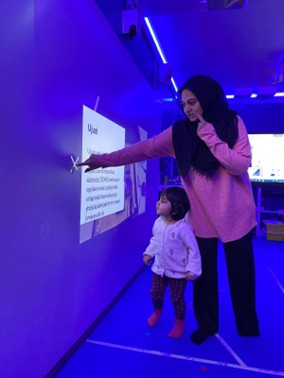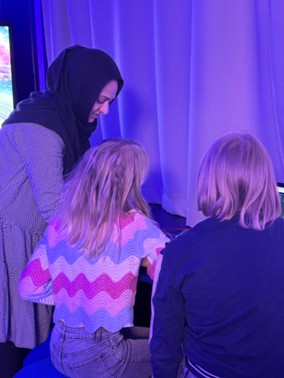Written by Kashifa Khalid
The Mobile Testbed TEKLA has enabled Edtech companies to pilot their products. Alongside this, a variety of loanable devices have traveled with TEKLA from school to school.
The journey of providing loanable devices to schools across Helsinki began at Sakarinmäki School, where TEKLA initiated its pilot program. These loanable, shared learning technologies were provided by the Helsinki Education Division. The aim was to make these learning technologies available for teachers to borrow and integrate into classroom teaching as part of TEKLA’s program. In the beginning six custom-built cabinets containing a range of devices were provided. These cabinets were moved by Helsinki Vocational College’s (STADIN AO) logistics students from school to school every 2-4 weeks.

Pop-up Sessions: Supporting Teachers and Planning Lessons
Initially, loanable devices were made available in the teachers’ lounge, ready for classroom use. It was observed that no one used them (loanable devices) at all. Discussions with the teachers revealed that they were reluctant to integrate these learning technologies into classroom teaching without tech support. They were concerned about encountering unexpected situations where they couldn’t resolve issues on their own. This led to the allocation of an EdTech facilitator, who assisted in the implementation of device integration in classrooms.
Moreover, to bridge the gap between device availability and meaningful classroom use, pop-up presentations were planned and organized at schools. These pop-up sessions were held in the teachers’ lounge during regular break times. This setting worked well because it was informal and accessible. Many teachers came during break time, often with a cup of coffee or snack in hand, which created a relaxed atmosphere. This made it easy for them to stop by, casually explore the equipment, try out different tools, and share ideas with the facilitator about how they might use the technology in their teaching. Having a facilitator on-site provided valuable support to both teachers and students during the implementation phase, helping to ensure smooth adoption and promote a more effective use.
Cabinet Transport and Structural Challenges
Cabinets were lockable and initially, an efficient solution for device storage and accessibility as each cabinet had a label including device photos, quantity, and a video tutorial link. In addition, each box had a designated space in the cabinet. This system made it significantly easier for teachers to identify and utilize the tools effectively. On the other hand, the cabinets’ design and durability posed several practical challenges. Cabinets were made of wood but were heavy even when empty, making them difficult to move, especially in schools without elevators.
Transporting these cabinets via van often led to structural damage: doors loosened, upper lids broke, and screws came undone. When dragged or pulled up, the top lids would detach, subsequently causing doors to break. These recurring issues emphasized the need for more durable, lightweight, and easily movable alternatives.
Transition to Rolling Cart and Organizational Issues
Due to damage, devices were moved from cabinets to rolling carts during the last week of March 2025. Although rolling carts were easier to move, they introduced a new set of challenges i.e. devices were no longer neatly arranged, charging devices proved to be challenging as charging cables were difficult to find, and the carts lacked the structured labeling system previously used on the cabinets. Additionally, stacking boxes in a rolling cart often led to clutter and confusion, making it difficult to access devices. This system led to inefficient device tracking and made it difficult to identify missing devices.


These pop-up experiences were especially impactful when held in unique spaces like TEKLA, where the environment added a wow effect and sparked interest among teachers. However, schools recommended holding these sessions in the teachers’ lounge due to time constraints, rather than at TEKLA.
In addition to pop-up presentations, EdTech facilitator ensured device availability and utilization. Though many boxes remained functional and reusable, some small devices were lost over time. To preserve the utility of devices, facilitator oversaw, managed, and maintained loanable devices across schools while keeping the devices updated and charged regularly for daily use.
Expanding the Device Pool and Compatibility Issues
As the project evolved, there was a growing need for additional and compatible tablets, for tools requiring specific applications. Most of the schools had older tablets that were not compatible with these apps.
Initially, we managed with a few tablets provided by TEKLA and attempted to install the necessary apps on school-owned tablets. The process of installing the app on school-owned tablets was time-consuming due to the approval procedures and device compatibility challenges. As a result, 15 tablets were leased from DigiHelsinki specifically for the project.
Charging Solution: Trolley Experience
With more tablets in use, highlighted a need for an on-site charging cart. To address this issue, a charging cart for tablets was introduced by (Koulukärry.fi) as part of a pilot project in collaboration with TEKLA. While it solved some challenges, it came with its own issues:
Subsequent improvements were made, i.e. installation of upgraded cables as well as discussion about installing a magnet-based system to prevent the loss of the main cable.
Future ideas
The experiences we gained so far have brought valuable insights that are
written by Kashifa Khalid – Project planner at TEKLA – JAVIST
Kashifa is passionate about making cutting-edge technology both accessible and impactful, turning traditional classrooms into dynamic spaces where students engage, create, and explore. She is thrilled to collaborate with motivated teachers to foster innovation in learning, empowering both teachers and students to embrace the future with confidence and curiosity.
